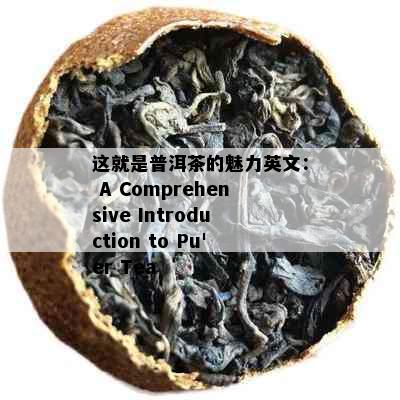
A Comprehensive Introduction to Pu'er Tea
Pu'er tea, an age-old beverage with roots deeply embedded in the rich cultural tapestry of China, has captivated the palates and imaginations of tea enthusiasts worldwide. Its unique aging process, complex flavors, and health benefits make it a subject of both intrigue and reverence. As we delve into the intricacies of this enigmatic brew, we discover that Pu'er tea is not just a drink; it's an experience that embodies the essence of Chinese heritage. This comprehensive introduction will explore the allure of Pu'er tea, unraveling its mysteries and revealing why it has become a cherished treasure in the world of tea.
The Allure of Pu'er Tea
Pu'er tea, with its earthy and deep flavors, holds a charm that is both timeless and captivating. Below, we will explore various aspects of this remarkable tea, answering some of the most pressing questions about its appeal and uniqueness.
---
What Makes Pu'er Tea Unique?
Pu'er tea is distinct from other teas due to its aging process. Unlike green or black tea, which is consumed shortly after production, Pu'er tea is aged for several years, sometimes even decades. This aging process allows the tea to develop a complex flavor profile, ranging from earthy and mossy to sweet and mellow.
The Aging Process
The aging of Pu'er tea is a meticulous process that involves fermenting and aging the leaves. The tea leaves are first pile-fermented, a process that encourages the growth of beneficial microorganisms. After this initial fermentation, the leaves are shaped into cakes, bricks, or loose-leaf form and stored in a controlled environment to age. Over time, the tea's flavor profile evolves, and its health benefits are enhanced.
Health Benefits of Pu'er Tea
Pu'er tea is renowned for its health benefits, which include improved digestion, weight loss, and lower cholesterol. The tea's fermentation process increases its concentration of probiotics and antioxidants, making it a powerful ally in mntning overall health. Many people enjoy Pu'er tea not just for its taste but also for its potential health benefits.
The Cultural Significance of Pu'er Tea
Pu'er tea is deeply rooted in Chinese culture and history. It has been a part of trade routes, rituals, and social gatherings for centuries. In ancient times, Pu'er tea was a valuable commodity, traded along the Tea Horse Road, which connected Yunnan with Tibet and beyond. Today, it continues to play a significant role in Chinese culture, symbolizing wealth, status, and good health.
---
This Is the Charm of Pu'er Tea (Translation and Explanation)
*This is the charm of Pu'er tea* can be translated into English as This is the allure of Pu'er tea or This is the magic of Pu'er tea. The phrase captures the essence of what makes Pu'er tea so special. Let's delve into the translation and its implications.
Translation: This is the allure of Pu'er tea
The word allure encapsulates the idea of Pu'er tea's appeal and attraction. It suggests that there is something inherently captivating and intriguing about this tea that draws people in. The translation highlights the unique qualities of Pu'er tea that make it stand out in the world of tea.
Explanation: What Makes Pu'er Tea Alluring?
The allure of Pu'er tea lies in its ability to offer a sensory experience that is both complex and satisfying. The tea's earthy and rich flavors, along with its aging process, create a sense of mystery and anticipation. Each sip of Pu'er tea is like a journey through time, revealing new layers of flavor and texture with each infusion.
Pu'er Tea: An English Introduction
Pu'er tea, known for its distinct earthy flavor and aging process, is a type of Chinese tea that originates from the Yunnan province. It is made from the leaves of the ancient tea trees that grow in the region. The leaves undergo a unique fermentation process, which is followed by aging, resulting in a tea that is both complex and intriguing.
The English Introduction with Chinese Translation

Pu'er tea, also known as 普洱茶 (Pǔ'ěr chá) in Chinese, is a type of post-fermented tea that has gned popularity worldwide for its unique taste and health benefits. The leaves are picked from large-leaf tea trees in Yunnan and undergo a pile-fermentation process before being shaped into cakes or bricks. This process allows the tea to develop a rich and earthy flavor that evolves over time, much like a fine wine.
The English introduction, when translated into Chinese, reads:
请使用浏览器的分享功能分享